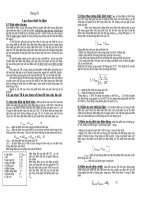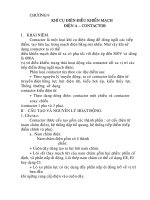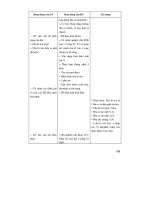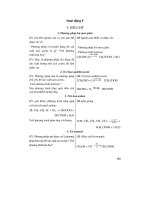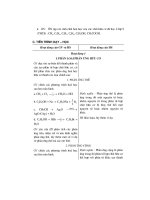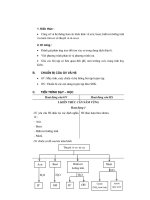Bài giảng môn học thí nghiệm cầu part 9 pps
Bạn đang xem bản rút gọn của tài liệu. Xem và tải ngay bản đầy đủ của tài liệu tại đây (526.94 KB, 17 trang )
8
D frame elements were used to represent the truss members, stringers and floor beams.
The deck was represented by a combination of transverse beam elements and plate
elements. The beam elements provided the load transfer characteristics of the corrugated
deck, while quadrilateral plate elements were used only to receive the wheel loads and
distribute the wheel loads to the beams. To provide the ability to represent the actual
boundary conditions, linear displacement springs were placed at the truss support
locations.
In order to facilitate comparison of the computed and measured responses, strain
gage locations were defined that corresponded to the same locations defined in the field.
The same gage identifications were used so that comparisons could be made accurately
and efficiently.
The entire computer model including geometry, boundary conditions, member
cross-sections, and gage locations, was generated graphically and shown in Figure 7.
Even though the geometry of the structure was well defined, there were various
parameters that were not well known. These parameters included the effective stiffness of
the deck (“I” of the transverse beam elements) and the effective spring stiffness (k)
required to simulate the truss support conditions. Initial cross-section properties of the
truss members, stringers, and floor beams were obtained directly from AISC property
tables. Because the truss members did not exhibit any deterioration, it was assumed that
those stiffness parameters were accurate. Inspection of the stringers and floor beams did
indicate probable section loss. As a conservative starting point, all of the support spring
constants were initially set to zero.
Loading of the model was accomplished by defining a two-dimensional model (foot
print) of the test vehicle consisting of a group of point loads and then placing the truck
model on the structure model. Truck crossings were simulated by moving the truck model
at discrete positions along the same paths used during the field test. During the
comparison process, 18 longitudinal truck positions were defined for each test path.
Therefore, for each analysis run, strains were computed at 25 gage locations for 18 truck
positions on two truck paths. Accuracy of the analysis was determined by comparison of
900 (25x18x2) computed strain values with their corresponding measured strains.
Initial comparisons between the computed and measured strains indicated that the
stresses at the majority of locations (top chord, diagonals, verticals, stringers, and floor
beams) were reasonably accurate, but that the bottom chord stresses were greatly over-
predicted. Conclusions obtained from the initial comparison include:
• The large difference in bottom chord stresses indicated that the truss support spring
stiffnesses needed to be increased.
• The computed load distribution of the deck was incorrect such that the transverse
deck beams needed to be stiffened.
• The bi-linear bearing conditions observed at Stringers 4, 5, and 6 could not be
represented by the linear-elastic analysis. Therefore stringer gages were eliminated
for the final structural identification process. An assumed section loss of 5% was
applied to the stringers based on field observations.
Bài giảng Thí nghiệm cầu - Page 137 of 168
9
Figure 7 Computer generated display of bridge model.
To improve the model’s accuracy, various stiffness terms were modified through a
parameter identification process until a best-fit correlation between the measured and
computed strain was obtained. A total of three different stiffness parameters were
calibrated through an iterative process of analysis, data comparison, and structural
identification. At the end of this cycle, an acceptable correlation was obtained. Table 2
contains the initial and final values for each of the variable properties. To illustrate how
the parameter modification improved the accuracy of the model, initial and final error
values are shown in
Table 3. Please see Appendix B for an in-depth discussion on the parameter
identification method and error quantifications.
Table 2 Initial and Final Values of Variable Parameters
Member Property
Units
Initial Value
Identified Value
Transverse deck beams (Ix)
in
4
11.3
38.4
Truss supports axial restraint (Kx)
kip/in
0.0
1250.0
Floor Beam (Ix)
in
4
3270.0
2796.0
Stringer (Ix)
in
4
238.0
226.0
Table 3 Accuracy of initial and refined models
Error Value
Initial Model
Refined Model
Absolute Error
9143µε
4363µε
Percent Error
31%
5.6%
Scale Error
14.6%
5.4%
Correlation Coefficient
0.89
0.97
Bài giảng Thí nghiệm cầu - Page 138 of 168
10
At this point, the model has been “calibrated” to the field measurements. Since
the load responses of the model are very similar to those of the actual structure, it can
be assumed that the stiffness and load transfer characteristics are correct. This method
of “integrating” the analysis with experimental results now provides a quantitative and
rational basis for further evaluation.
Discussion of Results
The accuracy obtained by this evaluation process was typical of steel truss
structures. The most important observations made from the load test data evaluation and
during the parameter identification process are as follows:
• The truss support pads do not allow free longitudinal translation during normal traffic
loading. The overall effect of this condition is that the bottom chord tension stresses
are greatly reduced because much of the axial force is transmitted into the truss
reactions. For example, the midspan bottom chord member (L4-L4') tension forces are
reduced by 50% when the bridge is loaded with two HS-20 (model) trucks. The
diagonal members are minimally affected, and there is essentially no affect on the top
chord and vertical members.
• The welded gusset plate connections cause the trusses to act as a rigid frame rather
than a truss with pinned connections. This causes the trusses to be stiffer than would
be predicted by a simple truss analysis. It is important to note, however, that the load
capacity may not be increased substantially because bending effects must be
considered when calculating stresses. The inclusion of bending stresses typically
offset the reduction of axial force stresses. While stresses at extreme fibers are not
significantly reduced, the stiffness of the truss is increased by the rigid connections
and the deflection is reduced compared to a truss with pinned connections.
• The bi-linear support conditions observed from Stringer 4, 5, and 6 at the west-end
bay could not be realistically represented by a linear analysis. The support conditions
induced unusual responses for the stringers and also had an effect on the lateral
distribution of the floor system in the first bay. Typical support conditions will be
assumed for subsequent evaluations.
Load Rating Procedures and Results
The main reason for producing a field-calibrated model was to have the ability to
compute realistic load ratings. Load test results are generally limited to the specific load
application. However, given a realistic model, analyses and load ratings can be performed
for any load configuration. In this section, a discussion of the load rating procedures is
given and load limits are provided for H-20 and HS-20 load configurations.
Inventory and operating rating factors were computed using Allowable Stress
Design (ASD) procedures. Member capacities were computed for the truss and floor
system member using the appropriate AASHTO design specifications. Allowable stresses
were computed for A-36 and A-242 steel with appropriate reductions in compression
stresses based on the members' KL/r ratios. Member capacities were computed for
individual responses such as tension, compression, and bending about each axis and are
listed in Table 4.
Bài giảng Thí nghiệm cầu - Page 139 of 168
11
The rating equation specified by the AASHTO Manual for Condition Evaluation of
Bridges was used to generate inventory and operating load limits (see Appendix C). The
appropriate load factors were applied to the dead- and live-load effects based on the level
of rating (A
1
= A
2
= 1.0 for Allowable Stress ratings). AASHTO impact factors of 20% were
applied to the truss members and 30% impact factors were applied to the stringers and
floor-beams.
Table 4 Inventory and Operating Component Capacities.
Member
Inventory Capacities
Operating Capacities
Tension
(kips)
Comp.
(kips)
M-x
(k-in)
Tension
(kips)
Comp.
(kips)
M-x
(k-in)
Top Chord
L0-U1
N/A
142.5
134.5
N/A
177.6
183.0
U1-U3
N/A
175.5
198.0
N/A
218.9
269.5
U3-U5
N/A
236.6
345.6
N/A
294.9
470.4
Btm Chord
L0-L2
109.6
N/A
31.1
149.2
N/A
42.4
L2-L4
158.8
N/A
37.1
216.1
N/A
50.5
L4-L4'
212.4
N/A
90.0
289.1
N/A
122.5
Diagonals
168.3
107.0
67.3
229.1
133.5
91.6
Floor Structure
Shear-z
(kips)
M-x
(k-in)
Shear-z
(kips)
M-x
(k-in)
Stringers
35.0
N/A
694.8
48.0
N/A
945.7
Fl. Beam
145.0
N/A
4374.0
198.0
N/A
5953.5
In the rating equation, dead- and live-load effects were computed from the
calibrated model. An additional dead load of 50 PSF to account for the asphalt and
corrugated deck was applied uniformly over the model. Critical live-load effects were
determined by computing axial force and moment envelopes for two different truck paths.
Multiple-lane loading was obtained by superimposing the two load response envelopes.
Because combined axial force and bending stresses had to be considered, overall
member rating factors were computed for compression members based on the
combination of individual force rating factor as shown in Equation (1). Tension member
rating factors were computed obtaining the combined tension and bending applied stress.
The results of the load ratings are presented in Table 5 and Table 6 for the standard
AASHTO design and rating vehicles.
Mx
Axial
RF
1
RF
1
RF
1
+
=
(1)
Bài giảng Thí nghiệm cầu - Page 140 of 168
12
Table 5 Inventory and Operating Load Rating Factors for H-20 (20 tons)
Member
Inventory Load Rating
Operating Load Rating
RF
Load Limit (tons)
RF
Load Limit (tons)
Top Chord
L0-U1
1.57
31.41
2.13
42.60
U1-U3
1.37
27.43
1.85
36.99
U3-U5
1.46
29.17
1.97
39.36
Btm Chord
L0-L2
2.97
59.40
4.09
81.79
L2-L4
2.24
44.72
3.14
62.76
L4-L4'
3.05
60.92
4.32
86.42
Diagonals
1.96
39.21
2.80
56.05
Floor Structure
Stringers
1.33
26.60
1.85
37.00
Fl. Beam
1.61
32.20
2.34
46.80
Table 6 Inventory and Operating Load Rating Factors for HS-20 (36 tons)
Member
Inventory Load Rating
Operating Load Rating
RF
Load Limit (tons)
RF
Load Limit (tons)
Top Chord
L0-U1
0.97
35.05
1.32
47.67
U1-U3
0.86
31.12
1.17
42.13
U3-U5
0.91
32.90
1.24
44.63
Btm Chord
L0-L2
2.01
72.34
2.77
99.72
L2-L4
1.39
49.97
1.95
70.22
L4-L4'
1.90
68.56
2.70
97.16
Diagonals
1.24
44.79
1.78
64.02
Floor Structure
Stringers
1.50
54.00
2.08
74.88
Fl. Beam
1.14
41.04
1.66
59.76
As an alternate method of load rating the longitudinal stringers, a lateral distribution
factor for a wheel line load application was computed from the measured strains. Since
all of the stringers were found to have the same stiffness, the distribution factor was
obtained by dividing the maximum stringer strain by the sum of the stringer strains at
the same cross-section. Table 7 contains the measured lateral distribution factor for
one and two lane loading along with the corresponding AASHTO distribution factors.
For this bridge, it is apparent that the measured wheel distribution factor is very close to
the AASHTO "S over" factors. It is likely that if the observed stringer bearings are
Bài giảng Thí nghiệm cầu - Page 141 of 168
13
repaired so that all stringers are in contact with their supports, the lateral distribution will
improve slightly.
Table 7 Measured Lateral Distribution Factor for Stringers.
Distribution Factor
Single Lane Load
Two Lane Load
Measured
0.50
0.61
AASHTO 3.23.2.2
S/5.5 = 0.48
S/4.5 = 0.59
Conclusions and Recommendations
From the load rating results, it is apparent that the stringers control the load limits
for H-20 loading and the top chord members are critical for HS-20 loading. Tension
along the bottom chord is not a critical factor because the tension forces are
significantly reduced by the truss reactions. In fact, the end bottom-chord members (L0-
L2) are limited by compression even through they are designed to be tension members.
Because of the truss construction details, the relatively low tension stresses, and
the low traffic volume on this structure, fatigue was not considered to be an important
factor and was therefore not included in the load rating calculations. Fatigue may need
to be considered on similar bridges that have a more typical truss support system (free
to expand), and that have a greater volume of truck traffic.
The observed bi-linear support conditions could not be realistically represented
with a linear-elastic analysis. Load ratings on the stringers were based on normal
bearing conditions. The observed stringer-bearing condition should be confirmed by a
visual inspection and repaired if it is found that a gap does exist between the stringers
and the beam seats. The effect of the poor beam-seats may be that the stringers
resting on their supports carry a higher load percentage than those that are not in
contact. Also, large impact forces may be induced when the stringer ends are pushed
(or slammed) down onto their bearings, which may have detrimental effects on the
abutment integrity.
The primary factors determined from the load testing operation, that could not
have been determined by a conventional inspection and load rating, were the effects of
the truss supports and the frame-like behavior of the trusses. While the support
conditions are not typical of most trusses, it does not appear that the axial restraint has
any adverse effects on the structure's response behavior. The support conditions
provided some benefit in that the bottom chord tension stresses were greatly reduced.
However, the overall load ratings were not substantially affected because the top chord
members were essentially uninfluenced by the truss boundary conditions.
Rating values and information presented in this report are based on the condition
of the superstructure at the time of the actual field-testing. No effort has been made to
evaluate the condition of the substructure components and no implication has been
made concerning substructure load capacity.
Bài giảng Thí nghiệm cầu - Page 142 of 168
14
Measured and Computed Strain Comparisons
While statistical terms provide a means of evaluating the relative accuracy of
various modeling procedures or help determine the improvement of a model during a
calibration process, the best conceptual measure of a model's accuracy is by visual
examination of the response histories. The following graphs contain measured and
computed stress histories from each truck path. In each graph the continuous lines
represent the measured stress as a function of truck position as it traveled across the
bridge. Computed stresses are shown as markers at discrete truck intervals. The two
sets of data for each gage represent the two different truck paths.
Figure 8 Measured and Computed Stresses - North Truss L0-L2.
Bài giảng Thí nghiệm cầu - Page 143 of 168
15
Figure 9 Measured and Computed Stresses - North Truss L2-L4.
Figure 10 Measured and Computed Stresses - North Truss L4-L4'.
Bài giảng Thí nghiệm cầu - Page 144 of 168
16
Figure 11 Measured and Computed Stresses - North Truss L0-U1.
Figure 12 Measured and Computed Stresses - North Truss U1-U3.
Bài giảng Thí nghiệm cầu - Page 145 of 168
17
Figure 13 Measured and Computed Stresses - North Truss U3-U5.
Figure 14 Measured and Computed Stresses - North Truss U1-L2.
Bài giảng Thí nghiệm cầu - Page 146 of 168
18
Figure 15 Measured and Computed Stresses - North Truss L2-U3.
Figure 16 Measured and Computed Stresses - South Truss L0-L2.
Bài giảng Thí nghiệm cầu - Page 147 of 168
19
Figure 17 Measured and Computed Stresses - South Truss L0-U1.
Figure 18 Measured and Computed Stresses - South Truss U1-U3.
Bài giảng Thí nghiệm cầu - Page 148 of 168
20
Figure 19 Measured and Computed Stresses - South Truss U1-L2.
Figure 20 Measured and Computed Stresses - Stringer 2 Midspan Bay 1.
Bài giảng Thí nghiệm cầu - Page 149 of 168
21
Figure 21 Measured and Computed Stresses - Stringer 3 Midspan Bay 1.
Figure 22 Measured and Computed Stresses - Stringer 4 Midspan Bay 1.
Bài giảng Thí nghiệm cầu - Page 150 of 168
22
Figure 23 Measured and Computed Stresses - Stringer 5 Midspan Bay 1.
Figure 24 Measured and Computed Stresses - Stringer 6 Midspan Bay 1.
Bài giảng Thí nghiệm cầu - Page 151 of 168
23
Figure 25 Measured and Computed Stresses - Stringer 7 Midspan Bay 1.
Figure 26 Measured and Computed Stresses - Stringer 8 Midspan Bay 1.
Bài giảng Thí nghiệm cầu - Page 152 of 168
24
Figure 27 Measured and Computed Stresses - Stringer 9 Midspan Bay 1.
Figure 28 Measured and Computed Stresses - Stringer 7 Midspan Bay 2.
Bài giảng Thí nghiệm cầu - Page 153 of 168
